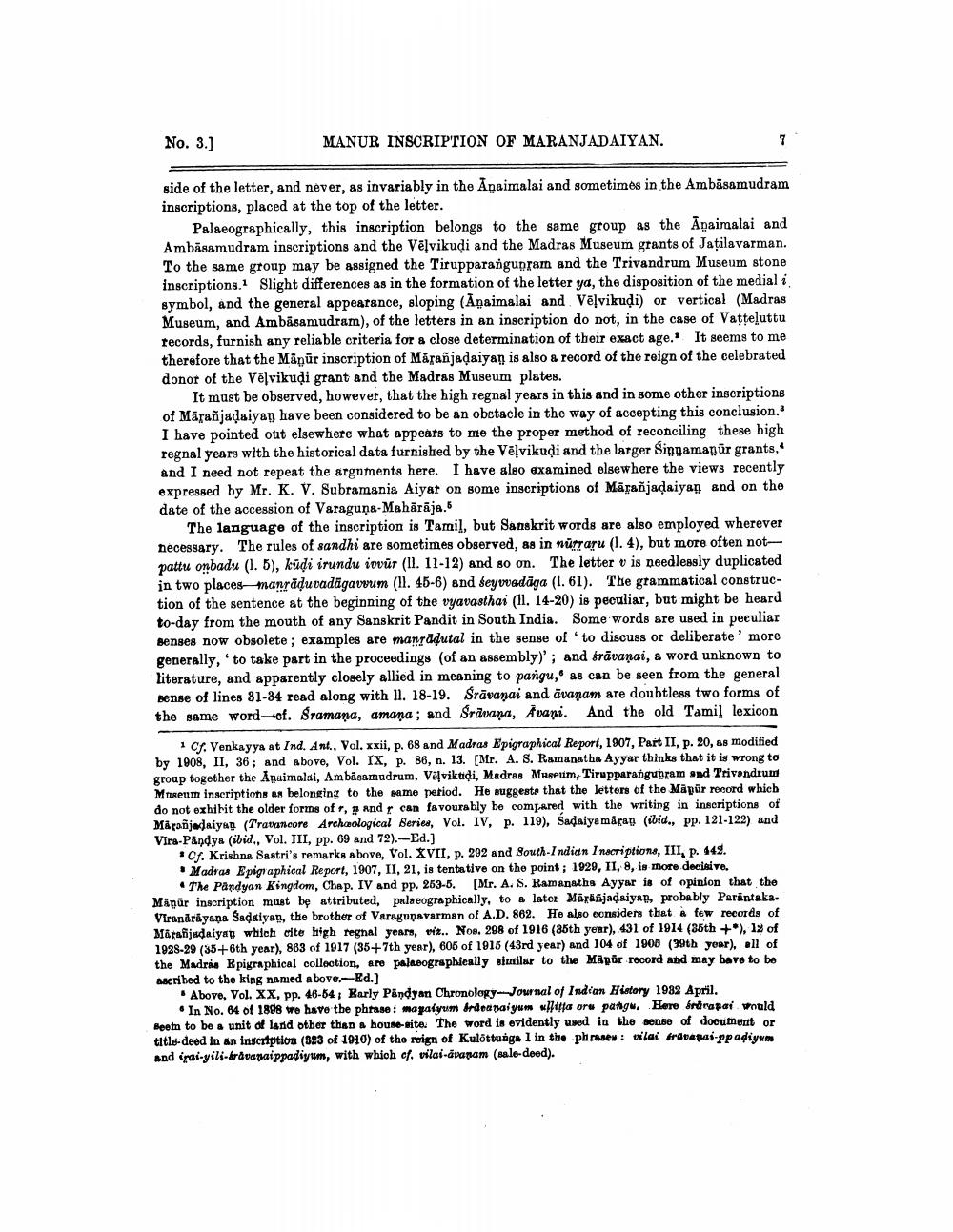________________
No. 3.]
MANUR INSCRIPTION OF MARANJADAIYAN.
side of the letter, and never, as invariably in the Agaimalai and sometimes in the Ambāsamudram inscriptions, placed at the top of the letter.
Palaeographically, this inscription belongs to the same group as the Apaimalai and Ambasamudram inscriptions and the Vēlvikudi and the Madras Museum grants of Jațilavarman. To the same group may be assigned the Tirupparangupram and the Trivandrum Museum stone inscriptions.1 Slight differences as in the formation of the letter ya, the disposition of the medial i symbol, and the general appearance, sloping (Anaimalai and. Vēļvikudi) or vertical (Madras Museum, and Ambasamudram), of the letters in an inscription do not, in the case of Vatteluttu tecords, furnish any reliable criteria for a close determination of their exact age. It seems to me therefore that the Mānür inscription of Marañjadaiyan is also & record of the reign of the celebrated donor of the Vēlvikudi grant and the Madras Museum plates.
It must be observed, however, that the high regnal years in this and in some other inscriptions of Mārañjadaiyan have been considered to be an obetacle in the way of accepting this conclusion." I have pointed out elsewhere what appears to me the proper method of reconciling these bigh regnal years with the historical data furnished by the Vēļvikudi and the larger Singamaņur grants, and I need not repeat the arguments here. I have also examined elsewhere the views recently expressed by Mr. K. V. Subramania Aiyat on some inscriptions of Mārañjadaiyan and on the date of the accession of Varaguņa-Mahārāja.
The language of the inscription is Tamil, but Sanskrit words are also employed wherever necessary. The rules of sandhi are sometimes observed, as in nurraru (1.4), but more often notpattu on badu (1. 5), kūdi irundu iovůr (1l. 11-12) and so on. The letter v is needlessly duplicated in two places-manrāduvadägavvum (11. 45-6) and seyvvadāga (1.61). The grammatical construction of the sentence at the beginning of the vyavasthai (11. 14-20) is peculiar, but might be heard to-day from the mouth of any Sanskrit Pandit in South India. Some words are used in peculiar senses now obsolete; examples are manrädutal in the sense of 'to discuss or deliberate more generally, 'to take part in the proceedings (of an assembly)'; and $rāvanai, & word unknown to literature, and apparently closely allied in meaning to pangu, as can be seen from the general sense of lines 81-34 read along with II. 18-19. Srāvanai and avaņam are doubtless two forms of the same word-cf. Sramana, amana; and Srāvana, Åvani. And the old Tamil lexicon
1 Cf. Venkayya at Ind. Ant., Vol. xxii, p. 68 and Madras Epigraphical Report, 1907, Part II, p. 20, as modified by 1908, II, 36; and above, Vol. IX, p. 86, n. 13. [Mr. A. S. Ramanatha Ayyar thinks that it is wrong to group together the Anaimalsi, Ambasamadrum, Vēļviktidi, Madras Museum, Tirupparangugram spd Trivandrum Museum inscriptions as belonging to the name period. He suggests that the letters of the Mapür record whicb do not exhibit the older forms of , and r can favourably be compared with the writing in inscriptions of Maroñjaiyan (Travancore Archaological Series, Vol. IV, p. 119), Sadaiya marap (ibid., pp. 121-122) and Vira-Pandya (ibid., Vol. III, pp. 69 and 72). -Ed.)
.of. Krishna Sastri's remarks above, Vol. XVII, p. 292 and South Indian Inscriptions, III, p. 142. • Madras Epigraphical Report, 1907, II, 21, is tentative on the point; 1920, II, 8, is more decisive.
The Pandyan Kingdom, Chap. IV and pp. 253-5. [Mr. A. S. Ramanaths Ayyar is of opinion that the Månür inscription must be attributed, palaeographically, to later Marijadaiyan, probably Parintaka. Viranåriyana Badaiyan, the brother of Varagupsvarmen of A.D. 862. He also considers that a few records of Marañjudaiyat which ofte high regnal years, vit.. Nos. 298 of 1916 (85th year), 431 of 1914 (35th +), 1% of 1928-29 (85+6th year), 863 of 1917 (36+7th year), 605 of 1915 (43rd year) and 104 of 1900 (39th year), all of the Madris Epigraphical collection, are palaeographically similar to the Mapur rooord and may have to be asenhed to the king named above.-Ed.)
. Above, Vol. XX, pp. 46-64, Early Pandyan Chronology Journal of Indian History 1982 April
• In No. 64 of 1898 we have the phrase: mapalyum Ardeanaiyum wifitfa ore pangu. Here ararapai would Beem to be a unit of land other than a house-site. The word is evidently used in the sense of document or title deed in an inscription (823 of 1910) of the reign of Kulottunga 1 in the phrases: vilai erdvapai-ppadiyum and inai.yili-Iravanaippadiyum, with which of wilai-ananam (sale deed).




